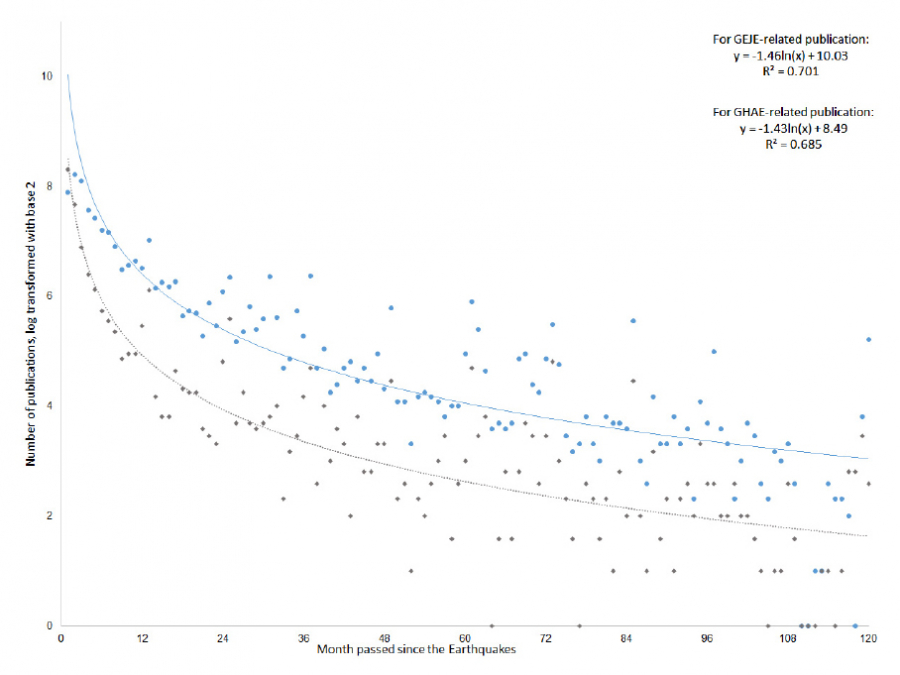Our results suggest that there has been a decline in public interest in the GEJE and FNPP accident. The reason that the number of GEJE-related publications did not decline in the first two months may be because of the continuous interest in the critical conditions of the FNPP which created uncertainty among people all throughout Japan. Our finding that the number of the GEJE-related publications was higher than that of the GHAE in almost all time periods may reflect the severity of the long-term social and environmental impacts of the GEJE and the FNPP accident on the public: public anxiety towards radiation spread over a wide area is a specific enduring result of the GEJE. Topics related to the GEJE may have been mentioned by more people in the Letters to the Editor over a longer period of time compared to those related to the GHAE, leading to the gap in the number of publications.
We need to be cautious about the possibility that the Letters to the Editor of newspapers do not reflect public opinion but rather create it. The media has the right to decide which articles to adopt and how to present such articles. Thus, the present results may be under the influence of such bias; the decrease in the number of GEJE-related publications may be a sign of declining interest on the part of the media rather than citizens. On the other hand, citizens refer to public opinion and also create new public opinions based on information from the media8). The decline in the number of publications related to the GEJE and FNPP accident in the Letters to the Editor may lead to a decrease in opportunities for citizens to be exposed to such topics, and therefore public interest may decline. Such a decline in the number of publications may be explained by the changing media environment. Although these newspapers were mainstream media at the time of GHAE, they may have been superseded by social networking services which have been spreading rapidly since 2011, when the GEJE and FNPP accidents occurred. Thus, the public may have had fewer opportunities to come into contact with topics about the GEJE and the FNPP accidents in newspapers. Regardless of whether Letters to the Editor reflect or create public opinion, the results of current analysis may have an equivalent meaning in terms of the difficulty in maintaining public interest in GEJE, FNPP accident, and their victims. Although a causal relationship between public opinion and publications in the Letters to the Editor of newspapers could not be examined due to the research design, it is notable that we found a decreasing trend in the number of publications in the Letters to the Editor of newspapers and that such a trend may be closely related to the decline in the public interest in GEJE.
One limitation of the present study is that it did not normalize the number of GEJE- and GHAE-related publications, and thus cannot deny the possibility that the difference of total circulation of newspapers from 2011 to 2021 for GEJE, and from 1995 to 2005 for GHAE, influences the number of publications in Letters to the Editor. Future research should therefore employ procedures to normalize or correct the publication numbers for a more precise comparison.
Even in 2021 with much progress made regarding the recovery and revitalization of affected areas since the GEJE and FNPP accident, mental health problems are prevalent among disaster victims in Fukushima9). Importantly, although mental health problems among disaster victims can occur years after a disaster, such victims may be socially neglected, and may not receive adequate mental health support when public interest in the disaster declines. In fact, Japan’s government budget for physical/mental health support has been gradually decreasing since the GEJE and FNPP incidents of 201110), and sustainable public mental health support is at stake. Maintaining the public interest years after a disaster may contribute to continued funds and to sustainable public mental health support for disaster victims. Although there is consensus in risk and crisis communication research on the need and importance for public mental health support in the relatively short period after a disaster, our results suggest that communication strategies suitable for the recovery period after the acute phase of disasters are needed in order to achieve sustainable mental health support for disaster victims. While risk and crisis communication are of importance at times of disaster, communication strategies that maintain high public interest in a previous disaster may be necessary in the recovery process to ensure that no victim is left behind.

